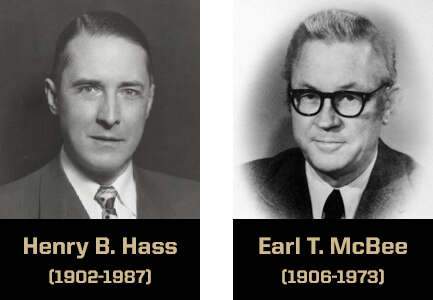Fluorine Chemistry research at Purdue during the Manhattan Project
2023-07-11
Writer(s): Steve Scherer

At Purdue in the 1930s, Professor Henry B. Hass and his then graduate student, Earl McBee, were applying fluorine chemistry to make safer anesthetics. At the time, cyclopropane was a general anesthetic gas used in operating rooms. However, nationwide there were several hospital accidents where the gas exploded.
“A few people had died on the operating table. So, we conceived the idea of making a noninflammable anesthetic, gaseous, and thought we could develop an ideal one by putting fluorine into the cyclopropane molecule. We started out to make fluorine-containing cyclopropane, which we never achieved,” McBee remembered in a 1970 oral history interview.
“Because we had been working in the field of fluorine chemistry for making an anesthetic, we were approached by the people in the Manhattan Project to undertake some research in fluorine chemistry for development of the atomic bomb,” McBee explained.
Around this time, scientists had discovered that uranium hexafluoride could be used in the process of enriching uranium - separating the fissile isotope uranium-235 from natural uranium. However, large-scale commercial production of elemental fluorine did not exist at that time.
McBee participated in many secret research conferences related to the fluorine chemistry side of the project. He was instrumental in getting the Hooker Electrochemical Company involved in the Manhattan Project, where the company developed commercial-scale fluorine cells using some of the fluorine compounds that were developed at Purdue.
At the beginning of the investigation, fluorine was being made in small amounts at an estimated cost of about $75 per pound. Because of the difficulty in its preparation and because of its highly corrosive nature, there was considerable doubt that it could be produced in the quantity necessary for the production of the desired materials. Therefore it seemed desirable to find a methods for the preparation of fluorocarbons using as little fluorine as possible. Purdue chemists proposed using hydrogen fluoride available in quantity at 15 cents per pound. Several possibilities were investigated; a process was developed for the preparation of bis(trifluoromethyl) benzene which was carried out in approximately a two and one-half million dollar plant at Niagara Falls. This compound was then converted to the fluorocarbon dimethylcyclohexane in approximately a forty million dollar plant in New Jersey.
- Chemistry Professor Earl T. McBee, Fluorination and Atomic Energy
After the war, Professors Hass and McBee would apply fluorocarbon research to develop and improve refrigerants, anesthetics, and insecticides - along with the synthesis of a wide array of halogenated hydrocarbons.
Link: 1970 Oral History with Earl T. McBee
Read more: